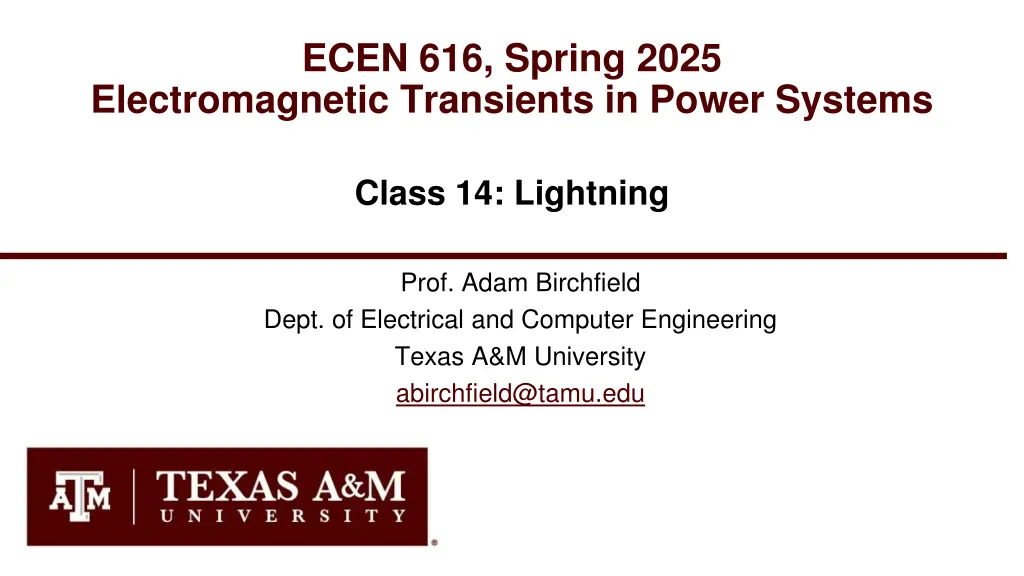
Understanding Lightning Strikes: Safety, Effects, and Mitigation Strategies
Learn about the frequency, peak voltage, and energy discharge of lightning strikes, along with safety measures to protect yourself during thunderstorms. Explore the effects of lightning on power systems, modeling lightning-induced surges, shielding strategies, and the role of surge arresters in preventing equipment damage.
Download Presentation

Please find below an Image/Link to download the presentation.
The content on the website is provided AS IS for your information and personal use only. It may not be sold, licensed, or shared on other websites without obtaining consent from the author. If you encounter any issues during the download, it is possible that the publisher has removed the file from their server.
You are allowed to download the files provided on this website for personal or commercial use, subject to the condition that they are used lawfully. All files are the property of their respective owners.
The content on the website is provided AS IS for your information and personal use only. It may not be sold, licensed, or shared on other websites without obtaining consent from the author.
E N D
Presentation Transcript
ECEN 616, Spring 2025 Electromagnetic Transients in Power Systems Class 14: Lightning Prof. Adam Birchfield Dept. of Electrical and Computer Engineering Texas A&M University abirchfield@tamu.edu
2 What is the Frequency, Peak Voltage, and Energy Discharge in a Typical Lightning Strike? 1 Hz 10 Hz 100 Hz 1 kHz 10 kHz 100 kHz 1 MHz 10 MHz 100 MHz 1 GHz 10 GHz 100 GHz 1 V 10 V 100 V 1 kV 10 kV 100 kV 1 MV 10 MV 100 MV 1 GV 10 GV 100 GV 1 Wh 10 Wh 100 Wh 1 kWh 10 kWh 100 kWh 1 MWh 10 MWh 100 MWh 1 GWh 10 GWh 100 GWh
3 Lightning Safety Lightning strikes have randomness about them, and can occur as far as 10 miles from rainfall If you hear thunder or see lightning, get immediately to a safe place, such as inside a fully enclosed building or metal vehicle If a lightning strike gets onto a metal pipe or wiring system, it can travel long distances, including into buildings Stay away from corded electrical equipment, showers, baths, and sinks, during a thunderstorm Unplug sensitive electronics or use surge protective devices What state had the most lightning strikes per square mile in 2024?
4 Effect of Lightning on a Power System Direct lightning stroke to equipment Direct lightning stroke to phase conductor Lightning stroke to shield or ground wire Lightning stroke to transmission tower Backflashover if the tower potential gets too high Lightning stroke to ground in vicinity of phase conductors
5 Modeling a Lightning-Induced Surge Basic Impulse Level (BIL) tests involve the current surge of a 1.2/50 ?? waveshape. This waveshape has a rise time of 1.2 ?? and a fall time (to 50%) of 50 ?? It can be represented with a double exponential ? ? = ??(? ?? ? ??) Where ? = 1.4?4 and ? = 4.5?6 There is also an 8/20us waveform
6 Shielding Shield wires are grounded conductors placed above the phase conductors to reduce the chance of direct strikes to the phase conductors How many and where to place them is shielding design
7 Surge Arresters When an overvoltage surge approaches a surge arrestor, ideally the device should clamp the system voltage to its nominal value, avoiding flashover and damage to equipment Including lightning, switching surges, etc. Technologies Rod gap: when voltage exceeds air breakdown voltage, an arc forms Silicon carbide Medal-oxide Modeled with nonlinear resistors
8 Capacitor Switching Switching caps Switching multiple caps in a bank Tripping cap banks Resonance with distribution Restrikes and prestrkes Autoclosing with precharge Harmonics Inrush Switching duty Three-phase clearing
9 Overvoltage Limits and Temporary Overvoltages Equipment has a nominal voltage at which it is designed to operate Maximum voltage is the highest voltage the equipment is designed to be continuously operated at. Normally this is 5-10% above nominal. There are different categories of temporary overvoltages depending on the expected timing of the overvoltage Fault overvoltages, which may last 10-100 ms, are typically 25-50% above nominal Switching overvoltages, lasting only a few ms or less, 2-3 times nominal Lightning overvoltages, 3-4 times nominal for a few microseconds (basic impulse level or BIL) Why else may overvoltages occur? Charging an open line, switching a line terminated by a transformer, load shedding, disconnection of inductances, fault clearance
10 Closing and Reclosing Transmission Lines Resonance Compensation, ferro-resonance Out-of-phase closing Impact of trapped charge
11 Arc Current Interruption When a breaker opens, there will be an arc of ionized air between the terminals, which must be extinguished to fully open the switch Current-zero breakers extinguish the arc when the current passes through a zero crossing Breakers usually take 2-5 cycles to interrupt the current fully
12 Modeling of System Grounding Types of grounding Solid grounded systems: typical for transmission and often distribution. Easier to detect faults and keeps voltages lower. Resistance grounded systems: occasional for industrial or distribution, and in some other countries. Fault current is more limited Low-resistance High-resistance Ungrounded systems Grounding safety considerations Step voltage Touch voltage Mesh voltage Fall of potential outside the grounding grid
